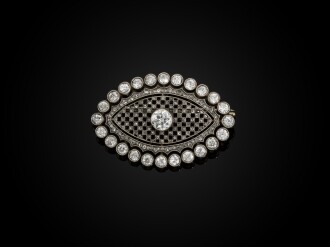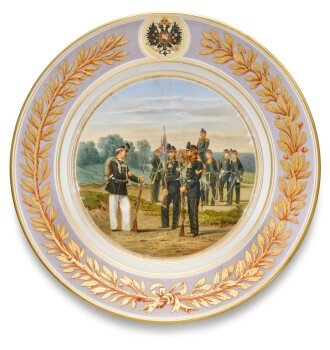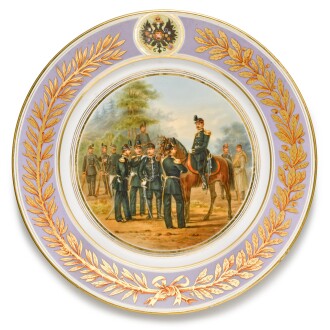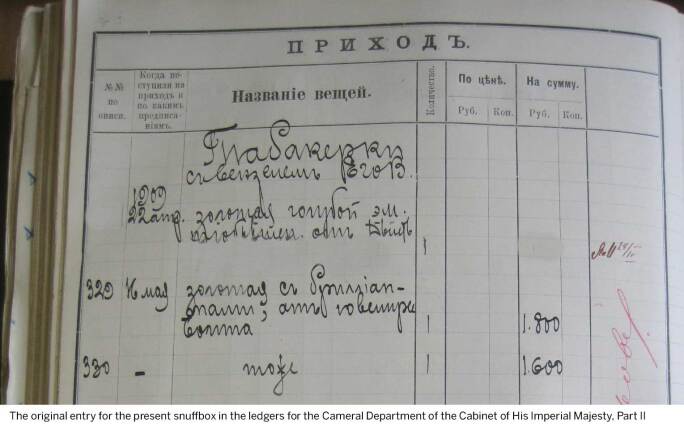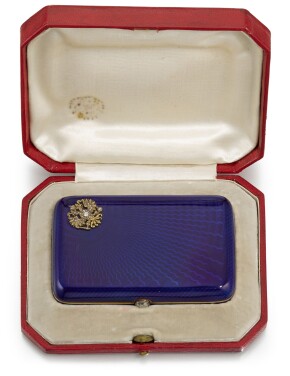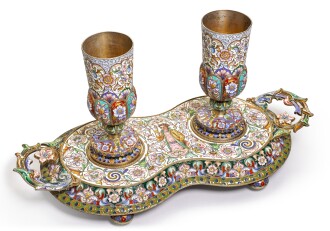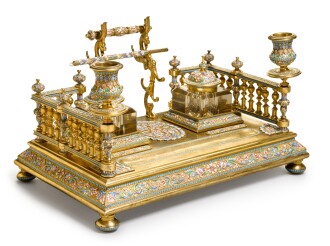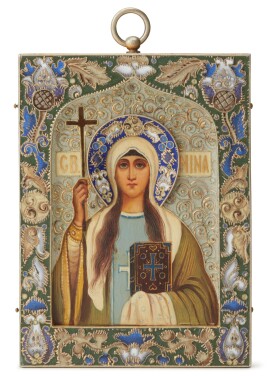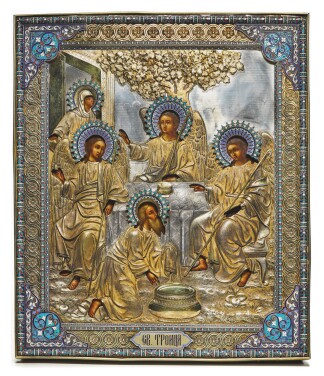L ed by an historic group of Fabergé and military porcelain, with significant exhibition history and provenance from an important UK private collection (lots 1-3 and 100-110), Sotheby’s June sale brings together an unprecedented group of imperial presentation pieces, including a snuffbox, presented to Vice Admiral Count Carl August Ehrensvärd (1858-1944) by Emperor Nicholas II during his state visit to Sweden in 1909 (lot 5). The sale also includes a rare group of twenty-four Russian Military Orders from an Important Swiss Collection, including a rare Collar of the Order of St Andrew (lot 6) and a seldom seen diamond-set, silver-topped, gold-mounted and enamel Grand Cross set of insignia for the Order of St Catherine, circa 1890 (lot 7). The collection includes further badges, breast stars and sets of insignia from each of Russia’s eight imperial military and civil orders (lots 73-94). New discoveries in the sale include a unique diamond-set platinum brooch, most likely a rare modernist design by Alma Phil (lot 4).
Auction Highlights

The sale is led by an outstanding group of Russian works of art offered from a Private Collection, UK (lots 1-3 and 100-110). The group includes three rare works by Fabergé, including an octagonal frame previously in the collection of Sir Edward Sassoon. This rare piece was formerly exhibited with a photograph of Lady Aline de Rothschild Sassoon. The Rothschild family were the most important patrons of Fabergé’s London branch, second only to the Royal family in terms of the scope and importance of their purchases. The collection also includes a kovsh, once in the Forbes collection, a rare hand seal, rhodonite desk set and a rare collection of sixteen Russian porcelain military plates, originally commissioned for Emperor Alexander II and his heir.
Featured Highlights
Coming to the market for the first time since it was acquired over three decades ago, this important Swiss collection (lots 6-7, 69, 73-94, 171-172, 195-199, 231-234 and 253) features twenty-four Russian Military Orders including several from the renowned Sandars collection. Alongside the orders, the collection is also represented by a rare silver and niello kovsh presented by Alexander I in the year of his coronation (lot 253), Russian porcelain, enamels and icons.
Featured Lots

- The Order of St. Andrew
The Order of St Andrew, also known as the Imperial Order of the Apostle St Andrew the First Called, was the highest order or decoration in the age of Imperial Russia. Reserved for those who displayed outstanding civilian or military merit, the order was established by Peter the Great in 1698. The order was briefly abolished during Bolshevik rule; however, it was re-introduced in 1998, the 300th anniversary of its existence, by Boris Yeltsin. It seems that Peter I was inspired to create the order following a seventeen-month-long visit to western Europe the previous year during which he encountered the English Most Ancient and Most Noble Order of the Thistle, which shared the same patron saint. Peter saw this order as a means to shift the award system away from gifts of land and money and towards a less expensive method that would also aid in his efforts to Europeanise Russia, which were at the time being met with strong opposition. Indeed, Peter I’s visit to western Europe was cut short because of the Streltsy Uprising in which the Moscow Streltsy regiments rebelled against the Tsar’s progressive innovations. Given the order’s motto, За вѣру и вѣрность (‘for faith and loyalty’), it is unsurprising that the first recipients of the prestigious award came from Peter I’s inner circle of friends and military men who assisted him in his efforts to modernise Russia.
Aside from individuals who had earned the title, members of the imperial family were automatically awarded the order at varying stages: Grand Dukes upon their baptism; blood Princes when they came of age; and empresses at their coronation. Under the reign of Paul I, the consort of the emperor was added to this list. In 1797, a distinction between earned orders and automatically granted orders was made – Russian Grand Dukes who had been awarded the order at their baptism were instead given diamond-covered insignia.
As with other orders, recipients of the Order of St Andrew were required to give a charitable donation by way of redemption fee and to participate in charitable activities. These included aiding the needy, visiting institutions such as hospitals, prisons and educational institutions, and overseeing the management of the latter. Knights would send their recommendations and suggestions to the sovereign after conducting such visits.
- The Order of St. Catherine
The bestowal of Orders was dependent on the rank of the recipient. The Imperial Order of St Catherine the Great Martyr ranked second in the hierarchy of the eight Orders of the time, after the Order of Saint Andrew the First Called. Along with the Order of St George, the Order St Catherine was independent from the correlation between awards and civil ranks. Other than the Order of St Olga which was only awarded between 1916 and 1917, the Order of St Catherine is the only Imperial Russian Order for women. Though the decoration of the Order of St Catherine was originally intended exclusively for Catherine I, it soon became a prestigious award reserved for a limited number of royal and aristocratic women. Established in 1713, the Order commemorated the Empress’s heroism in the Russo-Turkish Campaign battle by the River Pruth in Moldova, 1711, after she sold her jewellery and possessions to pay the Turkish army for the release of captured Cossacks. As Catherine I was not yet married to Peter I at this point in time, the Order was bequeathed upon the Empress on her name day, 24 November 1714 (after their official wedding on 19 February 1712), and she was made Grand Mistress of the Order.
The Order was divided into two categories, those of the Grand and Smaller Cross. Every female member of the royal family, a few foreign imperial and royal family members, and a very small handful of aristocratic women were granted the Grand Cross upon different milestones depending on their station. The Smaller Cross was usually bestowed upon other aristocratic ladies and the wives of prominent foreigners. A charitable donation of 400 roubles for the Grand Cross and 250 roubles for the Smaller Cross was demanded upon initiation into the Order. Women were elected to the Order, as opposed to those who were awarded the Order by their birthright, to honour their philanthropic deeds outside of the Court.
Though the Order was primarily ceremonial, it was also involved with substantial charitable work such as to hospitals, the churches of St Catherine, orphanages, the School of St Catherine for Young Girls of the Nobility, and funding of conversion for non-Orthodox individuals. Ladies of the Order were also required to swear an oath to the sovereign, including thanks and well wishes for the health of the sovereign and success in military ventures in their prayers.
- The Order of St. George
On 26 November 1769, Catherine II established the Imperial Military Order of Saint George the Victorious Great Martyr to commemorate outstanding military achievement. The Order was divided into four classes: members of the first two classes were elected by the sovereign, and they themselves appointed members of the third and fourth classes.
Insignia of the Order
The first class badge is a gold cross with white enamel on both the front and reverse. The front central medallion with red enamel features a depiction of St George slaying the dragon, whilst the reverse bears the letters СГ (or SG, for Saint George). The gold, four-pointed breast star is centred by an orange enamel medallion inscribed in gold with the Saint’s cypher and bordered by a black enamel band bearing the motto of the Order, ‘For service and bravery’, in Cyrillic. The sash is striped with black and orange. The badges of the second, third and fourth classes are identical to that of the first; however, with each decrease in level, the size of the badge also decreases. The position one wore the badge also depended on the class: first classes were worn over the right shoulder; second and third classes around the neck; and fourth classes on the breast. Badges awarded to non-Christians bear the imperial double-headed eagle in place of St George.
- The Order of St. Vladimir
Upon the 20th anniversary of her reign in 1782, Catherine II instituted the Imperial Order of the Apostolic Saint Prince Vladimir, which derived its name from Prince Vladimir of Kiev. The award of this Order represented recognition of lifelong military or civil service and outstanding service to the Russian empire. Unlike other orders which could be granted to imperial family members automatically, the Order of St Vladimir had to be earned.
Insignia of the Order
The cross-shaped gold badge hangs from a red and black striped sash across the right shoulder and is enamelled in red on both its front and reverse with gold and black borders. A crowned prince figure lies at the centre of a black enamel medallion on the badge’s front with the letters CB in Cyrillic, for Saint Vladimir, on his robe, whilst the founding date of the Order, 22 September 1782, is inscribed on the verso. The silver and gilded silver, eight-pointed breast star was worn over the left breast. Its central medallion was of black enamel bordered by red and illustrated with a gold cross and the letters CPКВ in gold.
- The Order of St. Alexander Nevsky
As legend recalls, in 1240, the warrior prince Alexander Nevsky led his army into battle against the Swedes and seized victory. Peter I intended to establish the Imperial Order of the Orthodox Saint Prince Alexander Nevsky in coordination with the transferral of the saint’s remains to their final resting place in St Petersburg, the St Alexander Nevsky Lavra, though his untimely death in 1725 hindered these plans. Catherine I instead established the order on his behalf that same year. High ranking army officials, civilians, courtiers, members of the nobility, and both Russian and foreign royalty had this order bestowed upon them.
Insignia of the Order
Between each of the four red enamelled and gold arms of the cross-shaped badge sit gold crowned double-headed eagles. An image of St Alexander Nevsky on his horse centres the white enamel and gold medallion on the front of the badge, whilst the medallion on the reverse features a crown above the Saint’s cypher. The badge hangs from a red moiré sash on the wearer’s left shoulder. The silver, eight-pointed star also has a white enamelled central medallion surmounted with a crown and the Order’s motto, ‘For labour and fatherland’ in gold. As with the Order of St George, non-Christian recipients of the Order was given a badge with imperial double-headed eagles instead of the image of the Saint.
- The Order of the White Eagle
One of the oldest of all European knighthoods, the Order of the White Eagle was founded in 1325 in Poland. In the eighteenth century, however, with the Polish partitions, the Russian Emperor Alexander I took control of the order and awarded it to his Polish subjects. It was officially absorbed by the Russian imperial award system in 1831 under the reign of Nicholas I, at which time the insignia was altered to include the imperial double-headed eagle. Eventually, this Order became one of the most important of the Russian empire. Though there was only one class, diamond orders were sometimes awarded, and military merit was commemorated by the addition of swords. Due to its Roman Catholic origins, Russian Orthodox clergymen were not awarded this particular order.
Insignia of the Order
The badge of the order is a gold Maltese cross pommy of red enamel and white borders. A white enamel Polish crowned eagle sits at the centre of an ornamented gold sunburst motif. This composition is superimposed over a black enamel, crowned double-headed eagle which hangs below an imperial crown with red enamelling. Traditionally, the eight-pointed breast star was made of silver, though this was temporarily changed to gold during the reign of Nicholas I. A red and white cross with the same sunburst motif centres the medallion and is surrounded by a dark blue enamel band which bears the Order’s motto, Pro fide, rege et lege (‘For faith, king and law’), in gold, though this cross was replaced with the imperial double-headed eagle for non-Christian recipients. The dark blue moiré sash was worn over the knight’s left shoulder.
- The Order of St. Anne
Unlike the other orders, which were instituted by the sovereign, the Order of St Anne was established by Duke Karl-Friedrich of Holstein-Gottorp in honour of Anna Petrovna, his wife and daughter of Peter I. The order was absorbed into the system of Russian knighthoods in 1797 at Paul I’s instigation. The order originally had three classes, though a fourth was added and inserted between the existing second and third classes in 1815. The original Holstein design of the first and second classes featured a red glass cross set with diamonds. Swords were added to badges of the first three classes to symbolise bravery in battle. In the case of third class badges with swords, a bow was also attached to it. After 1829, however, a crown was added to badges of the first and second classes and the star of first class awards. Diamond insignia were initially presented to both Russian and foreign dignitaries, though they were reserved for the latter from 1874 onwards.
Insignia of the Order
Stylised foliage sits between the four red-enamelled arms of the first class badge. The letters AJPF, for Amantibus justitian, pietatem, fidem (‘For lovers of justice, piety and fidelity) encircle an enamelled image of the Saint on the central medallion. The silver, eight-pointed breast star was worn on the right breast and features a red enamel cross on a gold-grounded central medallion. A wide, red enamel band borders the medallion and is inscribed with the order’s motto in silver. The badge was worn on a yellow-edged red moiré sash. The Saint’s image on the medallion was replaced with an imperial double-headed eagle when the order was awarded to non-Christians.
The badges of the second and third classes are identical to that of the first; however, with each decrease in level, the size of the badge also decreases. Fourth class badges, on the other hand, included a crowned, red enamel cross on a gold-grounded medallion. It was worn with the order’s ribbon and an ornamental silver tassel, and was attached to a sword. The position one wore the badge also depended on the class: first classes were worn over the left shoulder; second classes around the neck; third classes on the breast.
- The Order of St Stanislaus
In 1765, Stanislaus II Augustus of Poland established the Order of St Stanislaus. Following Poland’s partitions, the order joined the Russian system of knighthoods and was awarded by Alexander I to Polish subjects, just as with the Order of the White Eagle. It was officially absorbed by the Russian imperial award system in 1831 under the reign of Nicholas I, at which time the Order was divided into four classes, the first two of which included a breast star as part of its insignia. Due to its Roman Catholic origins, Russian Orthodox clergymen were not awarded this particular order. Eventually, the number of classes was reduced to three.
Insignia of the Order
The gold Maltese cross pommy badge is covered in red enamel on both the front and reverse. Gold double-headed eagles sit between the arms of the cross, whilst a white enamel medallion with a red entwined SS sits at the centre, encircled by the order’s motto, Premiando incitat (‘Encouragement by reward), written in gold. This was contained in a circle of gold enamel, decorated with gold laurel leaves. A red and white striped moiré sash was worn with the badge over the right shoulder, whilst the star was worn on the left breast. The Saint’s cypher was replaced with an imperial double-headed eagle when the order was awarded to non-Christians. The badges of the second and third classes are identical to that of the first; however, with each decrease in level, the size of the badge also decreases. The position one wore the badge also depended on the class: as already stated, first classes were worn over the right shoulder; second classes around the neck; third classes on the breast.

An Important Imperial Presentation jewelled gold and guilloché enamel snuff-box, workmaster Nikolai Chernokov, Bolin, St Petersburg, 1908-1917
length 8.1cm, 8 1/4 in.
Estimate £200,000-300,000
View Lot
Click on the red dots to discover more

This present lot is one of the most prestigious types of imperial presentation gifts. It was awarded to Count Carl August Ehrensvärd on Emperor Nicholas II and Empress Alexandra’s 1909 State Visit to Sweden.

Between 1712 and 1918, the Russian Navy ensign was the St Andrew’s flag, a white flag featuring a blue cross stretched diagonally across it. The choice of the same blue and white for the enamelling reflects the recipient Count Carl August Ehrensvärd’s position as Sweden’s Minister for Naval Affairs.

The present lot is in its original fitted Imperial Cabinet red leather case. The snuffbox and its case are recorded in the second volume of the ledgers for the Cameral Department of the Cabinet of His Imperial Majesty.



This widely exhibited Imperial Presentation Snuffbox appears for the first time on the market, offered by a Private Scandinavian Collector. This rare snuffbox by Bolin was completed and delivered to the Cabinet of His Imperial Majesty in March 1909. In Bolin’s invoice the box has an impressive price of 1,600 roubles and was a sumptuous gift to Vice Admiral Count Carl August Ehrensvärd (1858-1944) from Emperor Nicholas II, during his state visit to Sweden in 1909 The Imperial Russian court was renowned for presenting lavish gifts to Russian and foreign dignitaries, a tradition that flourished especially during the reign of Emperor Nicholas II.
Presentation snuffboxes with the Imperial cypher were typically awarded to Russians in state service. They were also awarded to foreign dignitaries as an act of diplomacy or as a means of commemorating special occasions connected to the Imperial family.
During the reign of Nicholas II, only 280 Russian subjects and 90 foreign dignitaries received Imperial presentation snuffboxes with the Emperor's jewelled cypher. Of these, only 21 were produced by the firm of Bolin between 1894 and 1917.
Featured Lots

This selection of works offered by an important family encompasses enamels, Fabergé silver and egg pendants (lots 18-21, 142, 144, 146-152, 156-164, 205), reflecting this collector’s deep understanding of and sensitivity towards Russian works of art and their most significant and influential makers. The variety of works Sotheby’s has on offer is fresh to the market after forty years in this one collection.
Featured Lots

Amongst the exciting range of Soviet porcelain (lots 174-183) Sotheby’s has to offer is a rare and large propaganda charger by Aleksey Vorobyevsky (lot 176), executed in September 1927 to commemorate the 10th anniversary of the USSR. Alongside this exceptional work are two plates after designs by the celebrated Alexandra Shchekotikhina-Pototskaya: ‘The Sailor Takes a Walk’, 1921 (lot 180); and ‘Young Man Reading the Newspaper Pravda’, 1923 (lot 182).
Featured Lots
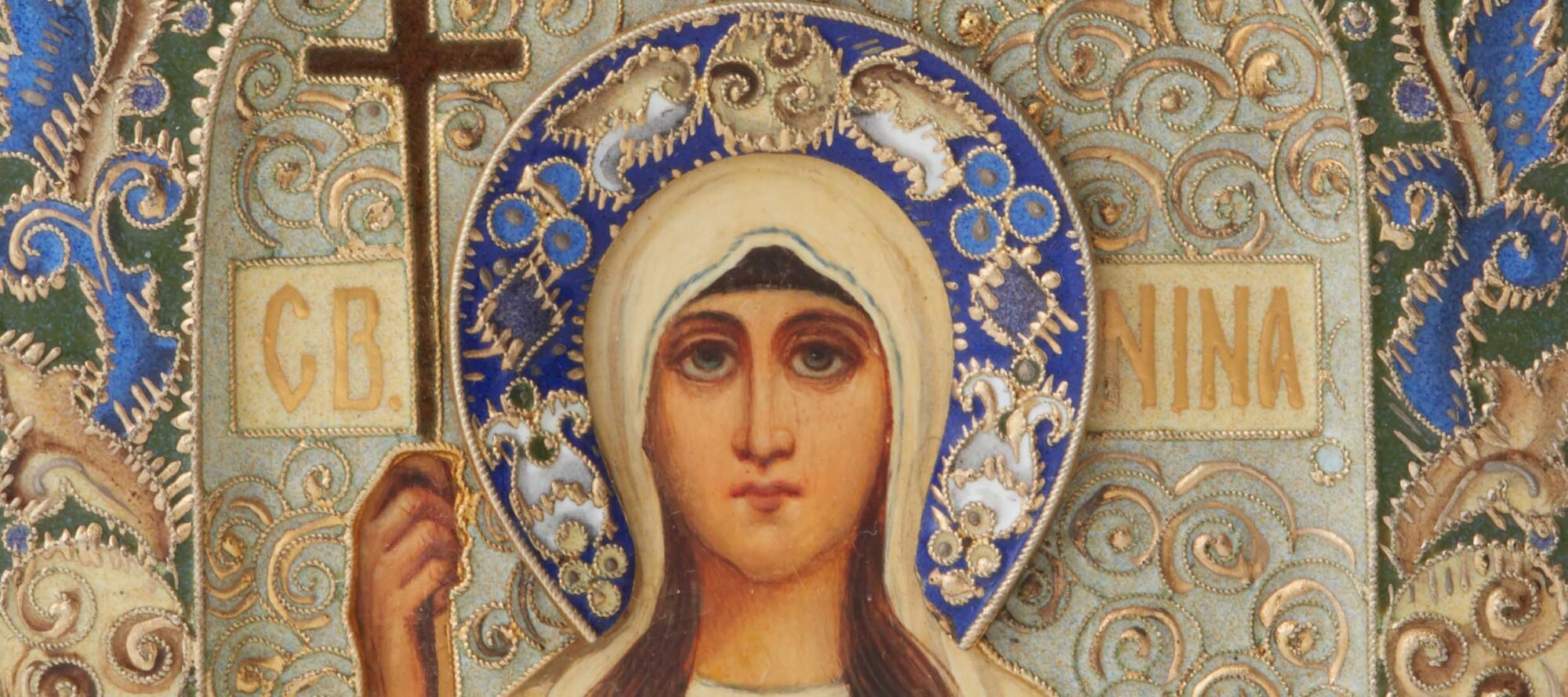
Sotheby’s icons on offer in the art nouveau style include a Fabergé icon of St Nina of Georgia by Rückert (lot 203), a 1st Moscow Artel icon of the Mother of God (lot 223), a Mother of God of the Three Hands icon by Sergei Zharov (lot 225), and an Icon of the apostles Peter and Pavel (lot 226). The Icon of St Anna Kashinskaya (lot 224) tops this group of art nouveau icons due to its special status as a presentation icon, gifted to Queen Olga Konstantinova by Prince Mikhail Andronikov in September 1909.
Featured Lots
Exhibition Times

| Friday 4 June | 10.00 - 17.00 BST |
| Saturday 5 June | 12.00 - 17.00 BST |
| Sunday 6 June | 12.00 - 17.00 BST |
| Monday 7 June | 10.00 - 17.00 BST |
| Tuesday 8 June | 10.00 - 17.00 BST |
| Wednesday 9 June | 10.00 - 12.00 BST |






